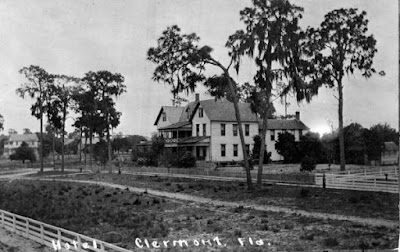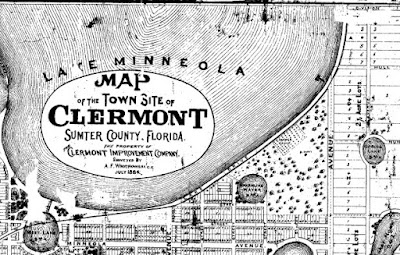CLERMONT of Lake County, and
Sister
City VINELAND, New Jersey
CLERMONT originated from MINNEOLA. Webb’s Historical of 1885, the encyclopedia of early Florida place names, listed only the town of Minneola. According to Webb’s, Minneola was settled in 1882 by George W. Hull, a Canadian (not George W Hull of Umatilla). But Webb’s also stated that two land agents were selling town lots at Minneola: Hull & Humiston Agency (George W. Hull & Ralph G. Humiston); and “Clermont Improvement Company”.
George W. Hull (1852-1914) was a Minneola merchant, and he established the Minneola Post Office on the 15th of February 1883. Nearly two years later, on January 21, 1885, a Clermont Post Office was established by Arthur F. Wrotnowski. Each post office was originally located in Sumter County, and both became Lake County post offices when the new county was formed in May 1887.
Clermont Improvement Company was based out
of Vineland, New Jersey, the hometown of Attorney William House (1838-1891),
President, and Fire Insurance Agent Thomas Steele (1835-1901), the Secretary. Town
of Vineland had been laid out in 1867 by Civil Engineer Arthur F. Wrotnowski, (see
Vineland Plat header this post), the Treasurer & General Manager of
Clermont Improvement Company.
A. F. Wrotnowski Civil Engineer 1867 Advertisement Vineland, New Jersey
Born in France, Arthur F. Wrotnowski
arrived in the USA with his parents at age 10, and settled first at Baton Rouge,
Louisiana. He and older brother Louis became Civil Engineers, and the two
brothers served with the Union Army in the Civil War - details reserved for
Chapter 29 of my book, Tavares: Darling of Orange County, Birthplace of Lake
County. After the War, Arthur served as Louisiana State Engineer, but also
became involved with Vineland, New Jersey, where in designed that city for
founder Charles K. Landis.
Header of 1867 Town Plat of Vineland, New Jersey surveyed by A. F. Wrotniwski
Arthur Francis Wrotnowski married Angie H. Bladine at her hometown of Philadelphia on February 4, 1885, within a couple of weeks of opening the Clermont post office in Florida.
Clermont Improvement Company had acquired
land adjacent to Minneola, Florida in 1882, and in July 1884, Surveyor Arthur
Wrotnowski extended two of Minneola's north-south streets further south. (See
upper right corner of Map of Clermont below). Disston and Bloxham Avenues,
as they crossed Division Street heading south, became part of a new town of
Clermont. Disston and Bloxham of Clermont originally extended all the way
south to Lake Minnehaha. (Tavares also had a Disston and Bloxham Avenue, and Chapters 3 and 4 explain the importance of each name to central Florida's development in the 1880s).
Header and portion of 1884 Clermont Town Plat by A. F. Wrotnowski
“William A. House, of Vineland, is
President of the Clermont Improvement Company,” reported New Jersey’s Bridgeton
Pioneer newspaper October 9, 1884: “He states the company owns fifteen thousand
acres of the finest land in Florida. A dozen families have already left
Vineland and Sea Ilse City to settle at Clermont.” One year later, House
relocated his family to Florida.
Access to Clermont in 1884 was via
stagecoach from Leesburg, but Wrotnowski’s town plat envisioned a “proposed
railroad” to run alongside Lake Minneola. That railroad right-of-way was
eventually used in 1886-87 by two railroads, Orange Belt Railway from Sanford to
St. Petersburg on the Gulf of Mexico (red arrow below); and Tavares, Apopka & Gulf Railroad
from Tavares with a plan to also terminate on the Gulf (red star below). The railroad
right-of-way is now a popular lakeside trail.
Born October 14, 1839, it is believed
Arthur had named his Florida city for his birthplace of ‘Clermont -Ferrand’. Arthur
F. Wrotnowski died in 1911 at Arizona.
Minneola Town Plat of 1925 shows path of the two railroads (far left) as they entered Clermont lakeside (bottom left) at Division Street - the line separating Minneola and Clermont.
Tavares, Apopka & Gulf Railroad was intended
to be Lake County’s Gateway from the Gulf of Mexico. It fell short of its goal,
but opened up Lake County towns Ellsworth Junction, Astatula, West Apopka (aka Ferndale),
Montverde, Wait’s Junction, Minneola, Clermont, and Mascotte. Each of these 19th
century places are featured in Chapter 29 of my Tavares book.
CLICK ON BOOK COVER TO BUY AT AMAZON
The holidays are quickly approaching. Why not give a lasting gift for the history buff in your family - Tavares: Darling of Orange County, Birthplace of Lake County.
Perfect companions: First Road to Orlando; Beyond Gatlin; Orlando Lakes; The Rutland Mule Matter; CitrusLAND: Ghost Towns & Phantom Trains. Visit my CroninBooks.com website for details on each.
Buy the Tavares book at Amazon by clicking on my book cover above.










